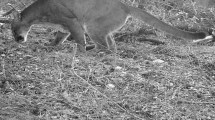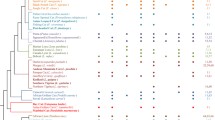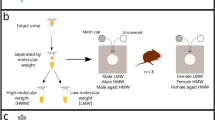Abstract
We used data from two troops of free-ranging vervet monkeys (Chlorocebus aethiops) to assess the proposition that the conspicuous chest rubbing observed in this species constitutes scent-marking behavior. Our data indicate that chest-rubbing behavior is associated with higher-ranking males who are more likely to do so during the breeding season in areas where territorial encounters occur. We found no indication that chest rubbing was triggered directly by encounters between troops. We conclude that these data, in conjunction with reports of chest rubbing from other Old World monkeys, are sufficiently suggestive of scent marking to warrant further, directed research and support the suspicion that olfactory cues remain important to catarrhines in a number of domains.





Similar content being viewed by others
References
Barton RA (1998) Visual specialization and brain evolution in primates. Proc R Soc Ser B Lond 265:1933–1937
Basckin DR, Krige PD (1973) Some preliminary observations on the behaviour of an urban troop of vervet monkeys (Cercopithecus aethiops) during the birth season. J Behav Sci 1:287–296
Clarke PMR, Barrett L, Henzi SP (2009) What role do olfactory cues play in chacma baboon mating? Am J Primatol 71:1–10
Gartlan JS, Brain CK (1968) Ecology and social variability in Cercopithecus aethiops and Cercopithecus mitis. In: Jay P (ed) Primates: studies in adaptation and variability. Holt, Rinehart and Wilson, New York, pp 253–292
Geissman T (1987) A sternal gland in the siamang gibbon (Hylobates syndactylus). Int J Primatol 8:1–15
Gosling LM, Roberts SC (2001) Scent-marking by male mammals: cheat-proof signals to competitors and mates. Adv Stud Behav 30:169–217
Gould L, Overdorff DJ (2002) Adult male scent-marking in Lemur catta. Int J Primatol 23:575–586
Heyman EW (2006) Scent marking strategies of new world primates. Am J Primatol 68:650–661
Hübener F, Laska M (1998) Assessing olfactory performance in an old world primate, Macaca nemestrina. Physiol Behav 64:521–527
Kappeler PM (1990) Social status and scent-marking behaviour in Lemur catta. Anim Behav 40:774–778
Kappeler PM (1998) To whom it may concern: the transmission and function of chemical signals in Lemur catta. Behav Ecol Sociobiol 42:411–421
McDougall P, Forshaw N, Barrett L, Henzi SP (2010) Leaving home: responses to water depletion by vervet monkeys. J Arid Env 74: 924–927
Montagna W (1972) The skin of nonhuman primates. Am Zool 12:109–124
Pochron ST, Morelli TL, Scirbona J, Wright PC (2005) Sex differences in scent-marking in Propithecus edwardsi of Ranomafana N.P., Madagascar. Am J Prim 66:97–110
SAS Institute (2007) JMP start statistics. Duxbury Press, Pacific Grove
Setchell JM, Vaglio S, Moggi-Cecchi J, Boscaro F, Calamai L, Knapp LA (2010a) Chemical composition of scent-gland secretions in an old world monkey (Mandrillus sphinx): influence of sex, male status and individual identity. Chem Senses 35:205–220
Setchell JM, Charpentier MJE, Abbott KM, Wickings EJ, Knapp LA (2010b) Opposites attract: MHC-associated mate choice in a polygynous primate. J Evol Biol 23:136–148
Thiessen D, Rice M (1976) Mammalian scent-gland marking and social behaviour. Psychol Bull 83:505–539
Acknowledgments
We are grateful to Mark and Sarah Tompkins for permission to work at Samara and to them and the reserve staff for logistical support. Ria Boner assisted with data collection and Kitty and Richard Viljoen, together with Leslie Brown and Tersia de Beer, helped in many, various ways. The study was funded by Natural Sciences and Engineering Research Council (Canada) and National Research Foundation (South Africa) awards.
Author information
Authors and Affiliations
Corresponding author
About this article
Cite this article
Freeman, N.J., Pasternak, G.M., Rubi, T.L. et al. Evidence for scent marking in vervet monkeys?. Primates 53, 311–315 (2012). https://doi.org/10.1007/s10329-012-0304-8
Received:
Accepted:
Published:
Issue Date:
DOI: https://doi.org/10.1007/s10329-012-0304-8




